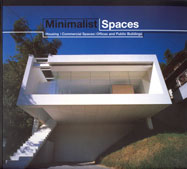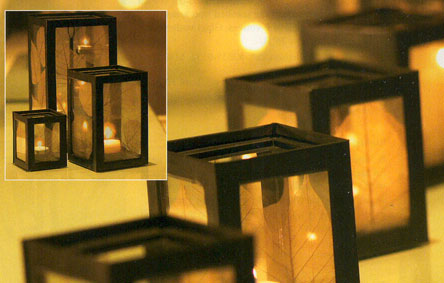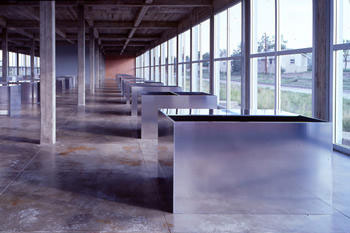![]()
Images and Influences.
Often when an
artist details a personal production process, it is problematic to formalize
influences
and images as well as detail a "complete" process.
When pursuing a large project, it is possible for hours, even days, to pass
in which an artist regains consciousness with a headache, a living
room full of paint,
a completed call list, a brush in his hand, or a laptop in his lap with
a total lack of perception of what has just occurred. To his best
ability, this individual must strive to document his work and formalize his
influences.
Documenting the process of a certain piece of work is complicated.
Rather
than a formal relationship with one or two distinguished and established
designers, architects, artists, or scholars I find my work being equally influenced
by a lamp post I once saw on a trip to Italy while zooming by a small town
at
2:30 in the morning. Unable to formally document the
lamp post, the incident or the image retreats temporarily into the recesses
of my
consciousness
only later to be "formalized and stylized" in a small journal diagram,
sketch, or napkin iteration. My life and my projects are filled with these
images and influences that often escape traditional
academic
classification. In other words, it is just as likely that Dan
Flavin's formal installations of fluorescent tubes in Richmond
Hall at the Menil Collection
in Houston, and the academic discussions that surround them; including
whether it is likely that Flavin's "icons", "corner pieces", "barriers",
and "corridors,
were
simply
"proposals"
inferring
the straightforwardness of his pieces, or whether Mr. Flavin was pursuing
minimalism by embracing the unadorned fixture as a viable aesthetic object,
could just
as easily drive a project of mine as a graffiti tag I
once saw in Chelsea,
New
York,
in 1994.
The following images and words, formal and informal, personal and professional,
minimal or absolutely beyond the scope of documentation drove
the work presented in the Opus fashion gala in April of 2002.

One of the largest formal publications that played a role in influencing the production design of the 2002 Fashion show was a book entitled Minimalist Spaces by Loft Publications, 2002, text Aurora Cuito, art direction Mireia Casanpvas Soley, and layout Emma Termes Parera. Within the publication the authors state, "this book is a journey through minimalist architecture. It is simply a question of space. The projects included in the book do share the desire to create defined pieces, whose meaning does not depend on an associated discourse or reflection on what has been evoked or how it has been done. Rather, the aim is to simply observe the designs and the way they interact with their surroundings." It was my intent for opus to follow this mode.
Questions encouraged through this publication included:
1. Is it possible
to reduce materials used in a project to the absolute minimum?
2. What is
the role of illumination, natural and imposed, on a minimum space?
3. Will color play a role? If so, what role will color play?

Barnett Newman's, Untitled #1, etching and aquatint, 1969 played a role in establishing the power of line and color. Painterly crisp edges, contrasting modulated colors, broad or thin bands, these are some of the words that describe Barnett Newman's works. In 1945 Mr. Newman published his ideas about abstract painting. In his own unpublished monologue, The Plasmis Image, he asserts that "modernist painters have solved the technical problems of the language of painting (color, shape, atmosphere) and should go on to transcend such decorative aspects of art to project concepts." Upon his return in the mid-1940s, Newman developed the above style of "zips" of single-hued fields. When Newmann extended his works and thinned his canvasses scholars mentioned that his "zips" became the painting. The large scale and prominent nature of the scrim on the set of Opus in effect became the set in a similar manner that it is argued Newmann's "zips" became his paintings.
1. When an artist's
palette is reduced to two colors what role does the comparing or contrasting
play?
2. How can you
balance a minimalist palette, or a palette of two colors? Is balance crucial?
3. Can one use of color be just as powerful as many?

Ursula 1000 is a collective of DJ's and musicians who work from the 18th Street Lounge, Washington D.C. Ursula 1000's work carries a strangely glamorous and esoteric feeling. For this reason, I knew from the beginning of the development of the audio that the sounds of Pleasure Unit off their self-titled album would play a key influencing role. Eventually the song mentioned above was actually used in the show.

One of the installations of Ellsworth Kelly, Wright Curve, 1996 influenced the inclusion of consideration of rounded edges and lines into the project. Much of my personal work relies on the balancing of straight grid systems, rather than simply including all straight lines; as presented in the Newman etching, the Kelly piece began proposing the opportunity for the inclusion of curved surfaces and lines.
1. Would including
a curved lines in the project enhance the environment or detract from it?
2. What kind of angles would be appropriate to contrast the straight lines
of the project?

Bohdi Leaf Lanterns, Illuminations 2002.
I stumbled across these leaf lanterns some time ago and cut them out of a commercial catalog. I was always fascinated by the ethereal quality that translucent objects seem to possess. This is one of the images that heavily influenced the use of sharks tooth scrim in the production design of the show.
1. Could I recreate the ethereal quality of translucency with light?

Part of the largest installation by the artist, Untitled (Marfa project), 1996 by Dan Flavin explores the relationship between illumination and architecture. "Recognized for his pioneering use of light and color divorced from traditional artistic contexts, Dan Flavin used fluorescent lights circumventing the use of frames, pedestals, and other conventional means of display. Having embraced the unadorned fixture as an aesthetic object, Flavin recognized the objects power to transform space." (Weg) Mr. Flavin once mentioned, "I knew that the actual space of the room could be disrupted and played with by careful, thorough compositions of illuminating equipment."
1. How would the inclusion of light
change the established production design?
2. Could light actually begin to
play a predominant role in the character of the show, therefore allowing
for the architectural characteristics
to be increasingly minimized?
3. How does imposed light react with the surrounding surfaces?
4. What are some of the substances and materials that allow for maximum flexibility
of light?
5. What are the most appropriate lighting fixtures?

Elayne Esterline, South Padre Island Texas, [photographer] kris swift 2001
A picture that I took in the summer of 2001 seemed to constantly influence Opus. The above picture initiated the inclusion of consideration of shadows as a influenceing element. In specific relation to Opus, the absence of light which is created when light is thrust onto scrim had just as powerful of an visual effect as the object that has itself been illuminated.

100 untitled works in mill aluminum, 1982-1986 by Donald Judd is installed in the permanent collection of the Chinati Foundation in a compound in Marfa in the Texas countryside. Working with "real materials in real space" in several of his projects Judd stated that he documented specifications for a certain project and then had another individual manufacture the actual pieces. Removing the hand of the artist, as Judd did through his manufacturing, I allowed a private design house to cut and sew my primary material to specification. Stressing purity of form, this work allowed for the exploration of exploring one material, illustrated and documented to a specific demensions, manufactured by another individual. Not fascinated with the inclusion of sequencing and iterations, my personal work explored a single medium (scrim) as Judd explored aluminum in the above piece.
1. How important is materiality?
2. What role does
subcontracting or the removal of the artist's hand relate to a production?
3. Is it more reasonable to subcontract
work to specification than it is to produce it solely?